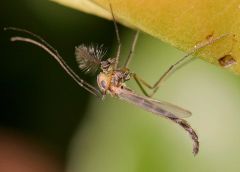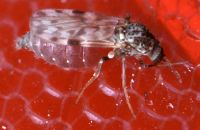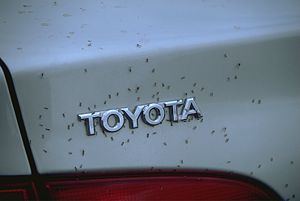Midge
- For other uses, see Midge (disambiguation).
Midges are small, two-winged flying insects. Midges are a subgroup of gnats, and comprise several families of Diptera, including especially the Chironomidae, or non-biting midges, and the Ceratopogonidae or biting midges (also known as no-see-ums or punkies in North America).
Biting midges fly in swarms and usually don't stray too far from their breeding grounds. Females feed on blood for protein to produce eggs. Males only feed on nectar.
Midges are important for the pollination of cocoa.
The orange wheat blossom midge is a pest in cereal grains and is a standard research animal used for the testing of pesticides.
The Highland midge is found in large numbers in the Scottish Highlands. They are famously vicious and have become something of a cultural icon in Scotland. They were also a favourite subject of author Vladimir Nabokov. Irish midges have a similarly fearsome reputation.
George Hendry, writer of Midges in Scotland, looks specifically into the biology of midges and why they bite.
Midges are at their worst on still, damp cloudy days. They do not like direct sunlight or high winds because their flight speed is less than human walking pace. This is why midges cannot immediately follow a person when running, although they can quickly gather again if a person stops moving.
Regional terminology in Northern Ohio for the non-biting species includes "muffleheads" and "muckleheads".
In South Africa they are universally known as "miggies", the Afrikaans word for midge.
In Singapore they are known commonly as sandflies.
A flightless midge species, Belgica antarctica, holds the distinction of being the largest land animal found on the continent of Antarctica.
They are a major food source for Trout.
Chironomidae
| Chironomidae | ||||||||||||||||
|---|---|---|---|---|---|---|---|---|---|---|---|---|---|---|---|---|
 Chironomus plumosus
| ||||||||||||||||
| Scientific classification | ||||||||||||||||
| ||||||||||||||||
|
See text |
Chironomidae (informally known as chironomids or non-biting midges) are a family of nematoceran flies with a global distribution. They are closely related to the Ceratopogonidae, Simuliidae, and Thaumaleidae. Many species superficially resemble mosquitoes but they lack the wing scales and elongate mouthparts of the Culicidae. This is a large group of insects with over 5000 described species and 700 species in North America alone. Males are easily recognized by their plumose antennae. Adults are known as "lake flies" in parts of Canada and as "blind mosquitoes" in Florida, USA. Larvae can be found in almost any aquatic or semiaquatic habitat, including treeholes, bromeliads, rotting vegetation, soil, and in sewage and artificial containers. Larvae of some species are bright red in color due to hemoglobin; these are often known as "bloodworms".
The family is divided into eleven subfamilies: Aphroteniinae, Buchonomyiinae, Chilenomyinae, Chironominae, Diamesinae, Orthocladiinae, Podonominae, Prodiamesinae, Tanypodinae, Telmatogetoninae, Usambaromyiinae.
Adults can be pests when they emerge in large numbers. They can damage paint, brick, and other surfaces with their droppings. When large numbers of adults die they can build up into malodorous piles. They can provoke allergic reactions in sensitive individuals. Larvae are important as food items for fish and other aquatic organisms. They are also important as indicator organisms, i.e., the presence or absence of various species in a given body of water can give a good idea of what kinds of pollutants may be present and in what quantities. Their fossils are also widely used as indicators of past environmental changes, including past climatic changes.
Ceratopogonidae
| Ceratopogonidae | ||||||||||||||||
|---|---|---|---|---|---|---|---|---|---|---|---|---|---|---|---|---|
 | ||||||||||||||||
| Scientific classification | ||||||||||||||||
| ||||||||||||||||
|
Forcipomyiinae |
Ceratopogonidae, or biting midges (or, in the United States, no-see-ums, sand flies, punkies, and others), are a family of small flies (1-4 mm long) in the order Diptera. They are closely related to the Chironomidae, Simuliidae, and Thaumaleidae. They are found in almost any aquatic or semiaquatic habitat throughout the world. Females of most species are adapted to suck blood from some kind of host animal. Culicoides, Forcipomyia (Lasiohelea), and Leptoconops suck vertebrate blood. Some Atrichopogon and Forcipomyia are ectoparasites on larger insects. Dasyhelea feed exclusively on nectar. Species in other genera are predatory on other small insects. Larvae are always found in some damp location, such as under bark, in rotten wood, compost, mud, stream margins, tree holes, or water-holding plants (i.e., phytotelmata). Many of the blood-sucking species, or those that feed via hematophagy, are pests in beach or mountain habitats. Other species are important pollinators of tropical crops such as cacao. The blood-sucking species may be vectors of disease-causing viruses, protozoa, and filarial worms.
ReferencesISBN links support NWE through referral fees
- Blanton, F.S. and W.W. Wirth. 1979. The sand flies (Culicoides) of Florida (Ceratopogonidae). Arthropods of Florida and Neighboring Land Areas Volume 10. Florida Department of Agriculture and Consumer Services.
- Borkent, A. and W.W. Wirth. 1997. World species of biting midges (Diptera: Ceratopogonidae). Bulletin of the American Museum of Natural History 233: 1-257.
- Clastrier, J. and W.W. Wirth. 1978. The Leptoconops kerteszi complex in North America (Diptera: Ceratopogonidae). United States Department of Agriculture Technical Bulletin Number 1573.
- Downes, J.A. and W.W. Wirth. 1981. Chapter 28: Ceratopogonidae. Pp. 393-421. In: McAlpine, J.F., B.V. Peterson, G.E. Shewell, H.J. Teskey, J.R. Vockeroth, and D.M. Wood. Manual of Nearctic Diptera, Volume 1. Agriculture Canada Monograph 27.
- Mullen, G.R. and L.J. Hribar. 1988. Biology and feeding behavior of ceratopogonid larvae (Diptera: Ceratopogonidae) in North America. Bulletin of the Society for Vector Ecology 13: 60-81.
- Wirth, W.W. and F.S. Blanton. 1974. The West Indian sandflies of the genus Culicoides (Diptera: Ceratopogonidae). United States Department of Agriculture Technical Bulletin Number 1474.
- Wirth, W.W. and W.L. Grogan, Jr. 1988. The Predaceous Midges of the World (Diptera: Ceratopogonidae; Tribe Ceratopogonini). Flora and Fauna Handbook Number 4. E.J. Brill Publishers, Leiden. xv + 160 pp.
- Wirth, W.W., N.C. Ratanaworabhan, and D.H. Messersmith. 1977. Natural history of Plummers Island, Maryland. XXII. Biting midges (Diptera: Ceratopogonidae). 1. Introduction and key to genera. Proceedings of the Biological Society of Washington, 90(3): 615-647.
- Hendry, George. Midges in Scotland 4th Edition, Mercat Press, Edinburgh, 2003 ISBN 1-84183-062-3
External links
- Scottish University project on midges
- Highland biting midge species profile
- Solving the problem of being ‘eaten alive’ by midges
- The sorghum midge: with suggestions for control hosted by the UNT Government Documents Department
Template:Fly-stub
Credits
New World Encyclopedia writers and editors rewrote and completed the Wikipedia article in accordance with New World Encyclopedia standards. This article abides by terms of the Creative Commons CC-by-sa 3.0 License (CC-by-sa), which may be used and disseminated with proper attribution. Credit is due under the terms of this license that can reference both the New World Encyclopedia contributors and the selfless volunteer contributors of the Wikimedia Foundation. To cite this article click here for a list of acceptable citing formats.The history of earlier contributions by wikipedians is accessible to researchers here:
The history of this article since it was imported to New World Encyclopedia:
Note: Some restrictions may apply to use of individual images which are separately licensed.
